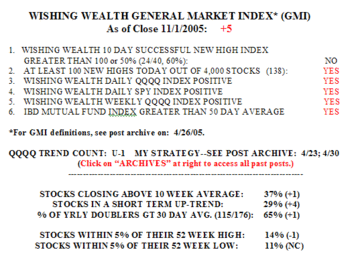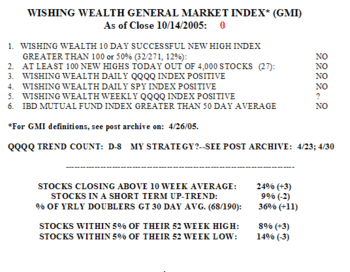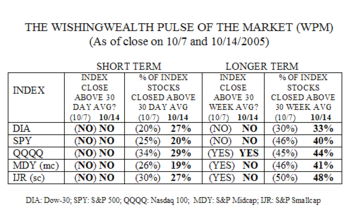The GMI is solidly at the maximum reading of +6. I am surprised that I listened to a local weekly radio commentator (Yudee Chang) Saturday morning (AM 570) who said we were in a "secular bear market." One of my fellow IBD meet-up participants also wrote that he was resisting this rally. Well, I fly on instruments. And the instruments tell me this market is in a confirmed up-trend, maybe the best this year. Three quarters of the 60 stocks that hit a new high 10 days ago closed higher on Friday than they closed 10 days earlier. 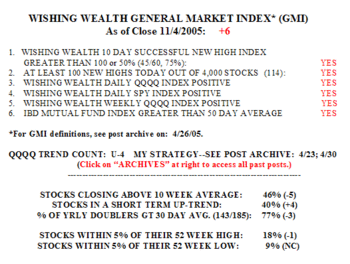 There were 114 new highs on Friday among the 4,000 stocks in my universe of stocks. Almost one half (46%) of the stocks closed above their 10 week averages, and 40% are in an up-trend, the highest since September 20, and up from 8% in mid-October. Three quarters (77%) of the stocks that have doubled in the past year are now above their 30 day averages, and twice as many stocks (18% vs. 9%) are within 5% of a new high as to a new low. This is the time for buying proven growth stocks at new highs.
There were 114 new highs on Friday among the 4,000 stocks in my universe of stocks. Almost one half (46%) of the stocks closed above their 10 week averages, and 40% are in an up-trend, the highest since September 20, and up from 8% in mid-October. Three quarters (77%) of the stocks that have doubled in the past year are now above their 30 day averages, and twice as many stocks (18% vs. 9%) are within 5% of a new high as to a new low. This is the time for buying proven growth stocks at new highs.
The WPM paints a similar bullish scenario. 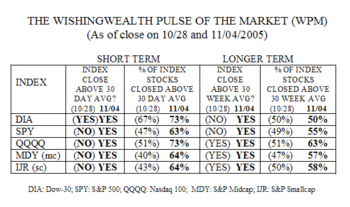 All five market indicators are now above their 30 day and 30 week averages. Two thirds or more of their component stocks closed above their 30 day averages and one half or more are above their 30 week averages. The Nasdaq 100, as measured by the QQQQ, is the strongest index. The time for tech stocks is here.
All five market indicators are now above their 30 day and 30 week averages. Two thirds or more of their component stocks closed above their 30 day averages and one half or more are above their 30 week averages. The Nasdaq 100, as measured by the QQQQ, is the strongest index. The time for tech stocks is here.
Over my 40+ years of trading, I have noticed that during the times when I have become so frustrated with the market that I have totally gone to cash, the market bottoms. The past 10 days I was in such a state of mind and therefore took the opportunity to transfer my account to a new broker. So, of course, the market bottomed while I had no access to my funds.
Now that I am ready to jump back into the market, I used TC2005 to scan the market for all stocks that hit a new high on Friday. In a new up-trend, the stocks that break first to new highs often become the leaders of the new cycle. I then refined the list of stocks to contain only those with high recent earnings or revenue increases, that have doubled in the past year, and that are near all-time highs. These are the stocks I will watch for further signs of strength, ranked by last quarter’s earnings increase:
KUB,BABY,GOOG,VTAL,NWRE,CUTR,RL,CPL,IX,TRAD,WVVI,
OCAS,DBRN,MKTAY,TMI,IRM,PETS,GS,ITG,GES,AOB,MRGE,
AQNT,KSU,ESLR,GROW, MGI.
All of thee stocks will not perform well. The key is to research them, pick a few, make pilot buys and then to slowly concentrate money in the few that prove themselves, always maintaining a stop-loss order as insurance against big losses.
Please send me your feedback at: silentknight@wishingwealthblog.com.
